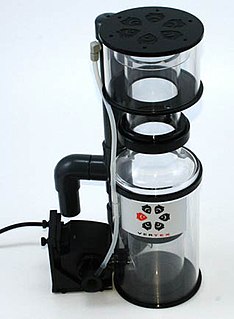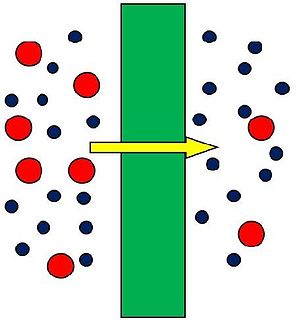
Filtration is any of various mechanical, physical or biological operations that separates solids from fluids by adding a medium through which only the fluid can pass. The fluid that passes through is called the filtrate. In physical filters oversize solids in the fluid are retained and in biological filters particulates are trapped and ingested and metabolites are retained and removed. However, the separation is not complete; solids will be contaminated with some fluid and filtrate will contain fine particles. Filtration occurs both in nature and in engineered systems; there are biological, geological, and industrial forms. For example, in animals, renal filtration removes waste from the blood, and in water treatment and sewage treatment, undesirable constituents are removed by absorption into a biological film grown on or in the filter medium, as in slow sand filtration.

A protein skimmer or foam fractionator is a device used to remove organic compounds such as food and waste particles from water. It is most commonly used in commercial applications like municipal water treatment facilities and public aquariums. Smaller protein skimmers are also used for filtration of home saltwater aquariums.

An air purifier or air cleaner is a device which removes contaminants from the air in a room to improve indoor air quality. These devices are commonly marketed as being beneficial to allergy sufferers and asthmatics, and at reducing or eliminating second-hand tobacco smoke. The commercially graded air purifiers are manufactured as either small stand-alone units or larger units that can be affixed to an air handler unit (AHU) or to an HVAC unit found in the medical, industrial, and commercial industries. Air purifiers may also be used in industry to remove impurities such as CO2 from air before processing. Pressure swing adsorbers or other adsorption techniques are typically used for this. One of the biggest advantage with the air purifiers is that, it will remove dirt particle which is naked to our eyes.

Sawdust is a by-product or waste product of woodworking operations such as sawing, milling, planing, routing, drilling and sanding. It is composed of fine particles of wood. These operations can be performed by woodworking machinery, portable power tools or by use of hand tools. Wood dust is also the byproduct of certain animals, birds and insects which live in wood, such as the woodpecker and carpenter ant. In some manufacturing industries it can be a significant fire hazard and source of occupational dust exposure.

Sand filters are used as a step in the water treatment process of water purification.
A particulate air filter is a device composed of fibrous or porous materials which removes solid particulates such as dust, pollen, mold, and bacteria from the air. Filters containing an adsorbent or catalyst such as charcoal (carbon) may also remove odors and gaseous pollutants such as volatile organic compounds or ozone. Air filters are used in applications where air quality is important, notably in building ventilation systems and in engines.

Flue gas is the gas exiting to the atmosphere via a flue, which is a pipe or channel for conveying exhaust gases from a fireplace, oven, furnace, boiler or steam generator. Quite often, the flue gas refers to the combustion exhaust gas produced at power plants. Its composition depends on what is being burned, but it will usually consist of mostly nitrogen derived from the combustion of air, carbon dioxide, and water vapor as well as excess oxygen. It further contains a small percentage of a number of pollutants, such as particulate matter, carbon monoxide, nitrogen oxides, and sulfur oxides.
Electrocoagulation (EC), aka radio frequency diathermy or short wave electrolysis, is a technique used for wash water treatment, wastewater treatment, industrial processed water, and medical treatment. Electrocoagulation has become a rapidly growing area of wastewater treatment due to its ability to remove contaminants that are generally more difficult to remove by filtration or chemical treatment systems, such as emulsified oil, total petroleum hydrocarbons, refractory organics, suspended solids, and heavy metals. There are many brands of electrocoagulation devices available and they can range in complexity from a simple anode and cathode to much more complex devices with control over electrode potentials, passivation, anode consumption, cell REDOX potentials as well as the introduction of ultrasonic sound, ultraviolet light and a range of gases and reactants to achieve so-called Advanced Oxidation Processes for refractory or recalcitrant organic substances.

A diesel particulate filter (DPF) is a device designed to remove diesel particulate matter or soot from the exhaust gas of a diesel engine.

A dust collector is a system used to enhance the quality of air released from industrial and commercial processes by collecting dust and other impurities from air or gas. Designed to handle high-volume dust loads, a dust collector system consists of a blower, dust filter, a filter-cleaning system, and a dust receptacle or dust removal system. It is distinguished from air purifiers, which use disposable filters to remove dust.

Secondary treatment is a treatment process for wastewater to achieve a certain degree of effluent quality by using a sewage treatment plant with physical phase separation to remove settleable solids and a biological process to remove dissolved and suspended organic compounds. After this kind of treatment, the wastewater may be called as secondary-treated wastewater.
A particulate matter sampler is an instrument for measuring the properties of particulates in the ambient air.

An immobilized enzyme is an enzyme attached to an inert, insoluble material—such as calcium alginate. This can provide increased resistance to changes in conditions such as pH or temperature. It also lets enzymes be held in place throughout the reaction, following which they are easily separated from the products and may be used again - a far more efficient process and so is widely used in industry for enzyme catalysed reactions. An alternative to enzyme immobilization is whole cell immobilization.
Black powder is an industry name for the abrasive, reactive particulate contamination present in all gas and hydrocarbon fluid transmission lines. Black powder ranges from light brown to black, and the mineral makeup varies per production field around the world.
Membrane bioreactor (MBR) is the combination of a membrane process like microfiltration or ultrafiltration with a biological wastewater treatment process, the activated sludge process. It is now widely used for municipal and industrial wastewater treatment.

Depth filters are the variety of filters that use a porous filtration medium to retain particles throughout the medium, rather than just on the surface of the medium. These filters are commonly used when the fluid to be filtered contains a high load of particles because, relative to other types of filters, they can retain a large mass of particles before becoming clogged.

A membrane is a selective barrier; it allows some things to pass through but stops others. Such things may be molecules, ions, or other small particles. Biological membranes include cell membranes ; nuclear membranes, which cover a cell nucleus; and tissue membranes, such as mucosae and serosae. Synthetic membranes are made by humans for use in laboratories and industry.
Copper zinc water filtration is a high-purity brass water filtration process that relies on the redox potential of dissolved oxygen in water in the presence of a zinc anode and copper cathode. It uses dissolved impurities within water as constituent substrate, which are reduced to more physiologically inert compounds.
Sam Sofer is an Iranian-born American scientist who specializes in biological processes and bioreactor design, with applications in medicine, energy, and the environment. He is the creator of biological air and water cleaners that use immobilized cell technology, and of various biomedical instruments and test protocols related to boosting the immune system to fight disease.















